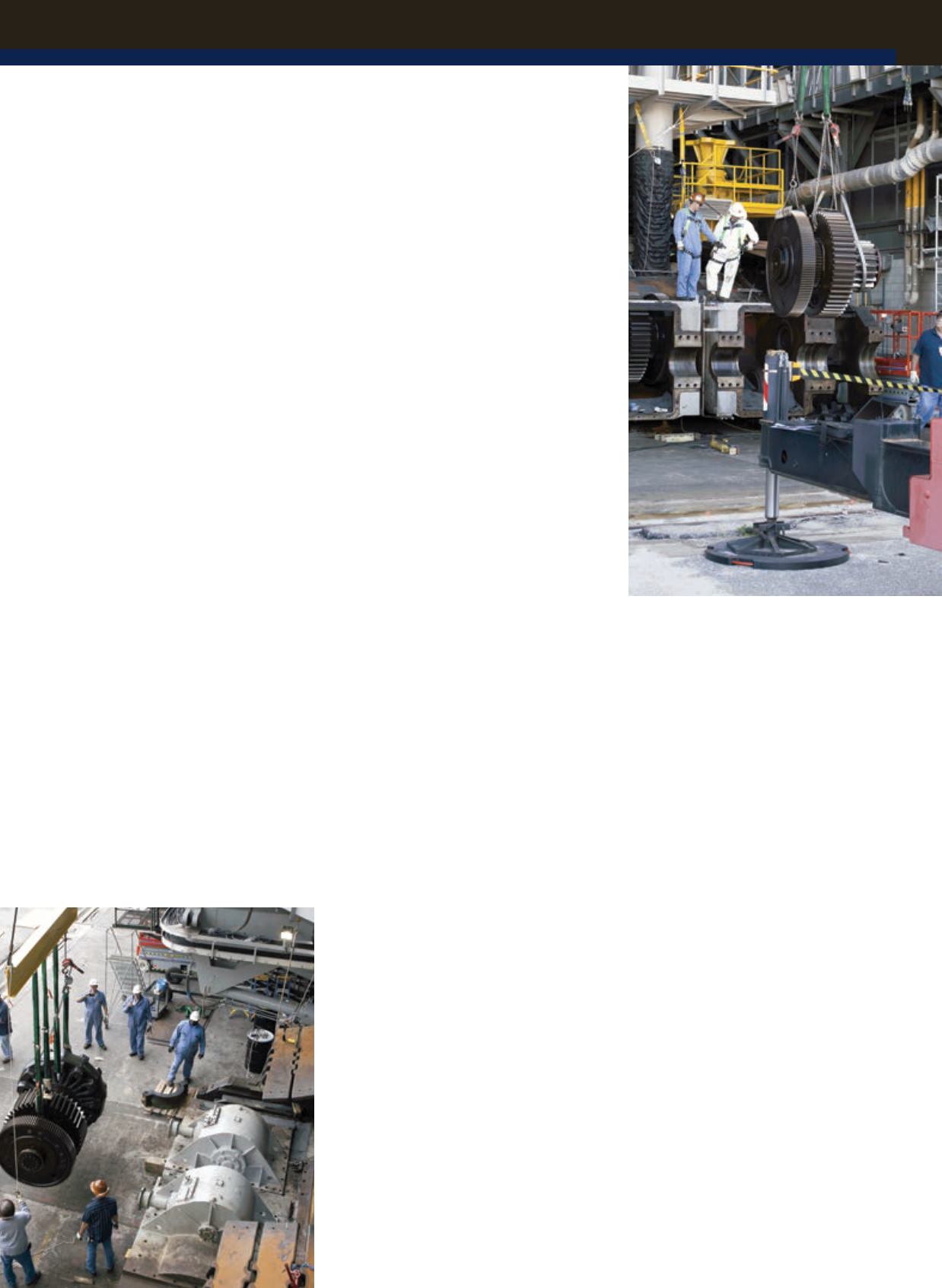
21
JANUARY 2015
ACT
RIGGINGREVIEW
In early 2014 at Kennedy Space Center in
Florida, DICA Safety Tech Outrigger Pads
were used in a traditional crane lifting
application. DICA DR422 Heavy Duty Safety
Tech Outrigger Pads, measuring 42 inches in
diameter by 2 inches thick andweighing 93
poundswere used under a 75-ton Link-Belt
HTC8675LB truck crane.
The cranewas replacing roller bearing
assemblies on the crawler-transporter that
will carry the SpaceLaunchSystem (SLS)
andOrion spacecraft to the launchpad
in2018. The crawler-transporters have
beenused formore than45years, but
nowupgrades arenecessary to increase
the lifted-load capacity from12million to
18millionpounds to support theweight
of themobile launcher and future launch
vehicles, including the SLS andOrion.
Over a series ofweeks, 22 liftswere
madeby JacobsTechnology,which
supportsNASA’s SLSprogram. The larger
lifts ranged from4,500 to26,000pounds
andweremadewith aLink-Belt truck
crane. Several smaller liftsweremadeby a
9-tonBroderson carry-deck crane.
JacobsTechnology currently supports
modifications toground support
equipment inpreparation for the first SLS
test flight, explainedMichaelWisnom,
aSystemEngineer responsible for
operation,maintenance, and lift planning
formobile cranes.
Early in the lift planningprocess,
Wisnom consultedwithCivil Engineers
regarding themaximum allowablebearing
pressures for the areaswhere the crane
wouldbe set up. “Althoughmost lifts
weremadeon asphalt surfaces,we also
neededoutrigger pads for general lifting
applications,” saidWisnom. Conservative
calculations determined that the ground
bearingpressureunder eachoutrigger
needed to stayunder 8,600psf.
Facedwith replacingwoodmats that
were inpoor condition,Wisnom turned
toDICA after seeing an ad in a crane
magazine. “Theypluggedour data into
their FIT® performance calculator and
presenteduswith several options. I liked
that the company is familyowned and
proudlypromotes their ‘Made in theUSA’
products,” saidWisnom.
Henoted that in comparison to common
rules of thumb for sizingmats,DICA’s
custom fittingprocess provided “whatwe
neededbut notmore.Using theRuleof 3
orRuleof 5wouldhave left uswith larger,
heavier outrigger pads thanweneeded.”
Safetyprotocols limit theweight that can
be liftedbyone individual to50pounds.
Since theDICA thermoplasticoutrigger
padsweighedunder 100pounds, only two
individualswereneeded tohandle them
insteadof theprevious threewithwood
mats. “The round shape andTuffGrip
handleswere also aplus for easeof
handling,”he said.
Ultimately, thedecision togowithDICA
overwoodoutrigger padswas a goodone
for JacobsTechnology. “DICAoutrigger
pads are the total package.Workingwith
DICA andusing their products is like
hitting theEASYbutton,”he said.
Finding the best set up
SafetyTechoutrigger pad features
that craneusers have come to rely
on, such as industrial grade safety
texturing andTuffGrip® handles,were
equally important for theLow-Density
SupersonicDecelerator (LDSD) project,
which is sponsoredby theNASASpace
TechnologyMissionDirectorate and
managedbyNASA’s Jet Propulsion
Laboratory inPasadena, CA.
Thepurposeof theproject is todevelop
ways toget larger payloads of supplies and
materials toMars for long-termmissions
to takeplace there in the future.A large
scientificballoonprovidedbyNASA
Wallops Flight Facility and theColumbia
ScientificBalloonFacility lifted a solid-
rocket powered test vehicle to an altitude
of about 120,000 feet. Inpreparation for
the launch at thePacificMissileRange
Facility, onKauai,Hawaii, theLDSDwas
hung from a launch tower, equippedwith
two jacks and twooutriggers.
DICA suppliedSafetyTechoutrigger
padsmeasuring117 inches by36 inches
by4 inches thick,whichwereusedunder
the jacks of the launch tower. Theballoon
launch tower is essentially a custom-built
trailerwith amast at one end. Two jacks
with18 inches by9-foot pontoons –one
at the front of the trailer andone at the
rear – support the150,000-poundweight
of the trailer plus 8,000pounds of rocket
weight. Itwas under these jacks that the
SafetyTech® outrigger padswereused.
Eachpontoon carriedhalf the total load
weight andhad todo sowithout slipping.
“Thematsworked reallywell andplayed
abigpart in theproject,” saidErichKlein,
aerospace engineer andproject leader for
theColumbiaScientificBalloonFacility,
which is based inPalestine, TX. “They
helpeddistribute the loadweight.”
“The textured surfaceof themats
providedgood friction togrip the
supports so that the tower didnot slide
around,” saidKlein. Known for being
lightweight, the customSafetyTech
outrigger padsweighed just 590pounds
each– significantly lighter thanwoodor
steel alternatives.
According toKlein, the teamwas
concerned about the ground’s ability to
withstand thepressures applied to it.
The launch tookplaceonoldU.S.Navy
runways built quicklyduringWorldWar
II. “These runwayswerebuilt in ahurry
The cranewas replacing roller
bearing assemblies on the crawler-
transporter that will carry the Space
Launch System (SLS) and Orion
spacecraft to Launch Pad in 2018.
PHOTO CREDIT: NASA/DIMITRI GERONDIDAKIS
PHOTO CREDIT: NASA/DIMITRI GERONDIDAKIS


